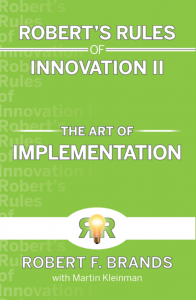
We’ve all seen those magazine lists of “most innovative” companies. Typically included are companies like Apple or, more recently, Tesla. Some are little more than popularity contests, others like Forbes do a better job of assessing how innovation is contributing to business success.
Without change, every company will eventually go out of business. Yet few companies are able to consistently get new ideas to market profitably.
To help improve your odds of success, innovation consultant Robert Brands just released a new book about the “art” of implementation with solid advice to overcome common obstacles. Here are five questions about his new book.
1. Why did you write this book? What do you want readers to learn?
The Art of Implementation is the logical follow-up to our first Robert’s Rules of Innovation (Wiley, 2010), which covered the imperatives on how to create and sustain Innovation.
“Execution” and “Solid Implementation” are the big challenges organization leaders face – this is what we found out in more than 100 workshops and leadership team exchanges.
This insight led us to creation of this hands-on information that allows readers to overcome the challenges and barriers and use best practices to improve and increase innovation success. It is an essential supplement to Robert’s Rules of Innovation.
2. In CustomerThink research, we found that a “culture of continuous improvement” was one of the top drivers of business performance. Yet precious few companies have this culture. Why?
Ah, culture. This is exactly what we discuss in Chapter IV: “Top-Down, Bottom-Up.” Culture is king – the key to successful innovation implementation. Unfortunately, there’s that bugaboo: daily life. We get bogged down with daily emergencies, fires and drills. Innovation, as well as Business Performance, needs continuous improvement and recalibration. This is because the market, technology and our customers are not static. The change is ongoing. A Structured Repeatable process is essential to effective ideation, which helps create new products and services to market.
With the right Inspiration, Reward system alignment and Accountability, improvement can be a regular focus, not a “once-in-awhile” thing.
3. Which do you think is more effective: driving ideas through a filtering (e.g. Stage-Gate) process, or working backwards from a customer need or “job” (as Steve Jobs, Clayton Christensen and others have advocated)?
Great question but what works best depends on the organization and culture. We drill down on this very topic in Chapter VI – “Ideate. Align. Repeat” – and actually explain eight steps to new product development. Bear in mind that if you start with a customer need or Job make, it is critical to first assess its manufacturability. Is it doable? Does a true market need exists and is well-defined? Ultimately it is about filling a need or market not just creating a product or service and hoping for the best.
4. What advice do you have for a CEO that wants to innovate, but doesn’t support the necessary risk taking?
There is no Innovation without risk-taking and the possibility of failure — and no long term success and endurance without Innovation. We address this in detail in Chapter II – “Innovation Assassination”. Set boundaries, agree to what is acceptable but, most importantly, see failure as a learning experience. Fight the culture of fear that permeates the halls of all too many organizations.
5. What ever happened to “open innovation”? Is it still a viable way to generate ideas and innovate?
Open Innovation, as we discuss in Chapter VII – “Crowdsource Your Way to Innovation” – is still flourishing and viable but it has to be part of a tactic to achieve innovation objectives along with crowdsourcing, co-creation, etc. Keeping you own in-house ideation efforts and development is a fundamental to understand your business, your client’s needs and market.
About the Author

Robert F. Brands is President and CEO of VariBlend Dual Dispensing and founder of Innovation Coach ® / www.innovationcoach.com
Brands authored “”Robert’s Rules of Innovation ®” with Martin Kleinman; The Ten imperatives to Create & Sustain “NEW” in Business, published by Wiley Publishing (2010) and The Art of Implementation (2015)
Between 2006 and 2009, Brands served Managing Director of the Personal Care Division of Rexam Plastics representing about $1B in sales, with 25 sites worldwide, about 11,000 employees in three Business Units: Dispensing Systems, Make Up and HPC (custom molding).
Rexam acquired Airspray NV, a worldwide leader in non-aerosol foam dispensers, in May of 2006. Under Brands’ stewardship as President of Airspray U.S. since 1998 and since 2004 as CEO of the Dutch public company, Airspray created the international market for instant foam dispensing. Here, Brands delivered consistent double-digit profitable growth.




Does your book address the use of innovation tools like IdeaScale?
Sure does, Chapter on: Crowdsource Your Way to Innovation
When Did It All Start?
Open Innovation, Co-Creation, Crowdfunding, and
Crowdsourcing—Compare and Contrast
What Types of Organizations Use Crowdsourcing?
Examples of Crowdsourcing
Crowdsourcing and You
Is Your Organization Ready to Crowdsource?
The Grand Challenge Contest